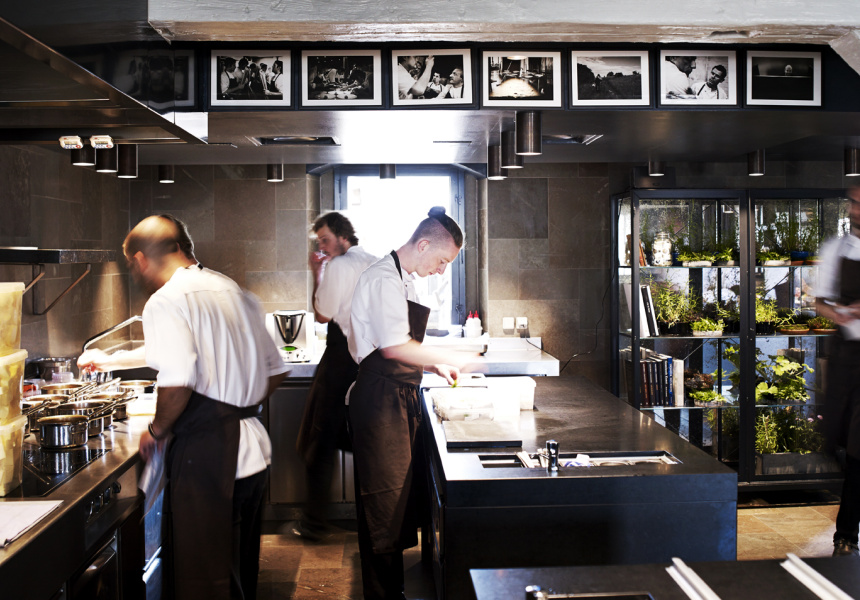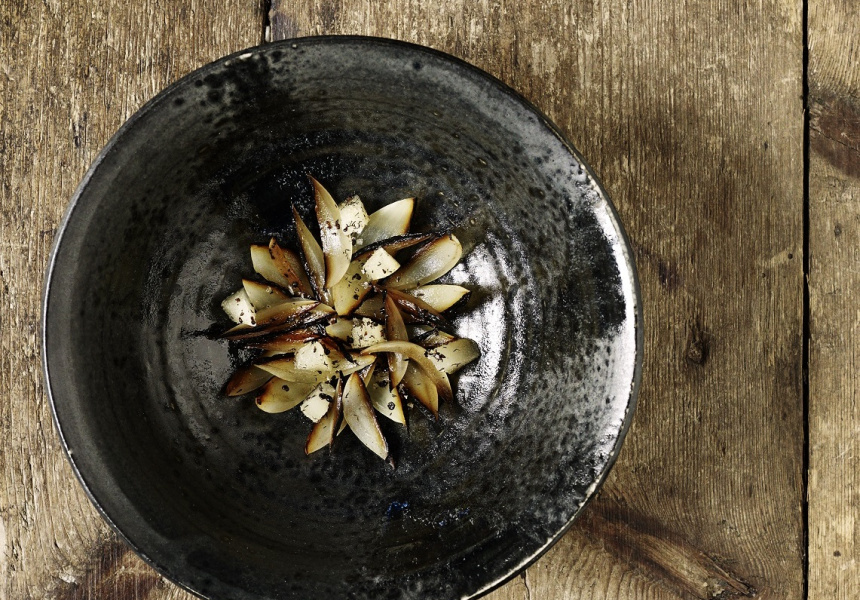Let’s get one thing straight: there’s no such thing as number one. No restaurant in the world can definitively be crowned “the best”. No single judge – or group of judges – could hope to visit every great restaurant on the planet, let alone distil those experiences into a truly objective list ranked from best to worst.
That said, there is something about the places that make The World’s 50 Best Restaurants list that capture a collective imagination, that push and bend our understanding of what food can be.
So it is with Noma in Denmark. Until recently, it held the top spot. It has held it for four of the past six years. Hence the excitement when it was announced that Noma would relocate to Sydney for 10 weeks in January 2016.
We think you might like Access. For $12 a month, join our membership program to stay in the know.
SIGN UPThe irony in all this is that Noma started out as a joke. When owner Claus Meyer hired rising-star chef René Redzepi in 2003, the venue was frequently referred to as “Whale’s Penis” – a jibe directed at its Nordic menu. At that time, Nordic cuisine was known as the even poorer cousin of German food, all pickled fish and stodgy root vegetables. Outside of grandmas’ kitchens and grubby old pubs, it didn’t really exist.
To add to Noma’s supposed disadvantages, it was (and still is) located in a culturally barren part of Copenhagen. Imagine Quay plonked down at Padstow Heights, or on the Port Botany industrial foreshore, and you have an accurate picture. Of course, Noma’s ultra-seasonal New Nordic cuisine made this a non-issue very quickly.
This backstory was percolating in my head last month as I sat in a cab watching the streets of Copenhagen roll by. The restaurant’s isolated location means the staff can see you coming from the nearest drop-off point, which is a good 20 metres away. Someone stands at the door watching.
By the time my wife and I had exited the cab and made it inside, the 20 chefs who work the open-plan service kitchen had clustered around the door. Every waiter not serving other customers had joined them. It was like walking into a surprise party.
But instead of yelling “Surprise!” a ripple of cheery greetings – “Welcome to Noma!”; “Thank you for coming!” – passed rapidly around the semi-circle. It was impossible not to feel overwhelmed. By the time we’d recovered, we were seated in rustic timber chairs, our coats had mysteriously disappeared, and the 30 or so greeters had returned to their tasks around the white, driftwood-clad space.
This impeccable service will no doubt carry over to Sydney, thanks to the 30 estimated experienced waiters who are flying out with Redzepi and the other chefs. As in Copenhagen, they’ll ensure meals appear and disappear with little fanfare, the ins-and-outs of the service darting by in your peripheral vision and never really demanding too much attention. No one ever asked us, “Would you like some more butter?” It just arrived and slipped onto the table as needed.
Ah, the butter. Like a lot of what I ate at Noma, it was the best version I’d ever tasted. Noma makes the “virgin butter” itself, churning cow’s milk into sour, buttermilk-rich pats. Likewise, whole wheat is milled in-house for the sourdough, which arrived steaming and perfectly caramelised. If ever the warning “Don’t fill up on bread” applied, it’s here. It’s just so hard not to.
It’s hard to say how Noma will replicate this end-to-end approach on the opposite side of the world. The required infrastructure is immense. Downstairs in Copenhagen, 20 chefs work the service kitchen from 7am to 11pm most days. Upstairs some 30 interns – many former head chefs elsewhere – do all the preparation in a space maybe half the size of a basketball court. Three more chefs, including Redzepi himself, do full-time R&D and menu planning in a smaller kitchen.
Outside, there are four shipping containers for fermenting food such as barley, split peas, potatoes and used coffee grounds. Apart from Redzepi’s fascination with the pongy, unusual flavours this process produces – nearly every one of our 19 courses made some use of it – it ties into the idea that if the ingredients aren’t truly seasonal, they should be preserved using pre-industrial techniques such as pickling and drying.
But once the ingredients reach the kitchen, the full weight of modern gastronomy is thrown behind them. One course was a black garlic “leaf”, made by pureeing aged, caramelised garlic, spreading it onto a sheet, drying it, then cutting it into a leaf shape. A thin ant paste was applied to the underside for acidity. Berries straddled the leaf to add just a faint hint of sweet fruit.
Another was a cold, perfectly clear soup made by steaming lobster claws, pressing them to extract all the liquid, and then ice filtering it. At this point – and many others during the meal – we weren’t eating so much as tasting pure flavour.
Other dishes were simpler, but no less inventive. The very first was a single turnip and a single unripe strawberry soaked in aquavit and served on a bed of ice chips. Who ever thought of eating an unripe fruit? Not me. But I will in future, provided its bitterness is so cleverly played off against the smart of hard spirits.
This devotion to technique, and using it to distil ingredients down to their most basic, powerful forms, will no doubt figure strongly at Noma in Sydney. Only this time, the ingredients won’t be 100-year-old mahogany clams (“We have a friend who hand-dives for them for us in the Lofoten region in Norway,” the manager told us), Swedish scallops or Danish greens. They’ll be local samphire, Tasmanian pepperberries or native finger limes from Queensland. Expect seafood to figure strongly: it isn’t as affected by the seasons Redzepi cooks by.
Regardless of the ingredients, Noma’s results always end up sounding fussy and ridiculous on paper. It was no less so when they were put down in front of us by the chefs who deliver and explain many of the dishes. It was only when each dish found my tongue that my inner cynic paused for breath.
More than anything, Noma highlights the role expectation plays in dining. Both the kind you have in the weeks leading up to your visit, and the 10 seconds between hearing about each course and getting to taste it. It repeatedly sets you up, then knocks you down.
The best example of this was the plate of leaves that arrived for the third course. Not a salad. A plate of leaves, arranged in a neat grid. They’d been foraged that morning, we were told. Right … but it’s still a plate of leaves. Right?
Kind of. The plate itself was brushed with liquefied scallops, giving the fresh leaves a concentrated umami underside. Some of the leaves were steamed, others chargrilled. Some were spicy (horseradish leaf), while others were herby (parsley leaf). I’ve never eaten leaves so carefully and joyously in my life. Nor with my hands, either – something which happened a surprising amount, considering the fine-dining setting.
But for all this culinary magic, there were times when things went too far. Times when I felt more like a bit player in a modern-art performance than a paying diner. Take the new Danish potatoes, tiny, gumball-sized spuds that were presented wrapped in a parcel of – you guessed it – leaves.
“Use these branches as your utensils,” the chef said, handing us each a large, leafy branch with a sharpened point for spearing potatoes. It was unwieldy and added nothing to the experience of eating potatoes.
At this point you have to wonder whether this is innovation for the sake of it; pretentious novelty rather than genuine ingenuity. But if staying at the top is about constantly surprising and exciting your guests, then it seems obvious that a restaurant must dance on this boundary, even if it means getting it wrong occasionally.
It doesn’t help that the boundary is subjective and incredibly blurred. I still don’t know exactly how I feel about the food we ate. I didn’t enjoy everything, but there was barely a moment during the four-hour meal when I wasn’t excited or intrigued, whether it was eating chocolate-covered mushrooms for dessert or sampling sheep’s-yoghurt mousse.
Depending on your point of view, that makes the experience a triumph (overcoming a person’s particular dislikes with sheer panache) or a bit of a failure (serving unappealing food). At Noma there’s no theatre in the outrageous Heston Blumenthal sense, but there’s still a certain amount of wide-eyed wonder when you bite into a “sandwich” that uses crispy cabbage for the bread and a paste made of of samphire, watercress and rose petals for the salty, floral filling.
More than anything else, it’s this quality that characterises dining in the upper echelon. There’s not much room for steak, or quiche, or gnocchi, or tacos, or dumplings. Everyone’s eaten those things. So if you’re René Redzepi, you don’t make them again, you push the boundaries instead.
The result is food that most people wouldn’t want to eat every day, even if it didn’t cost $500 a head (including wine). For the most part, we eat for satisfaction, not to be surprised or struck with wonder. When those things become a restaurant’s raison d'être, it becomes hard to compare it with anything else. It’s better to just sit back and watch the magic unfold. Now it’s your turn, Sydney.
Noma will move to Barangaroo, Sydney for 10 weeks in January 2016.


